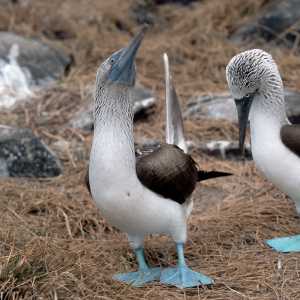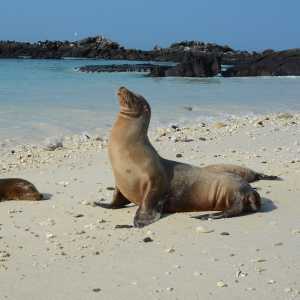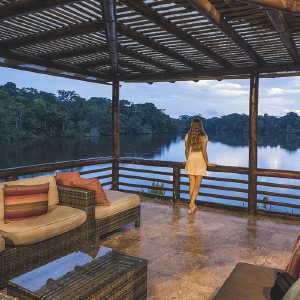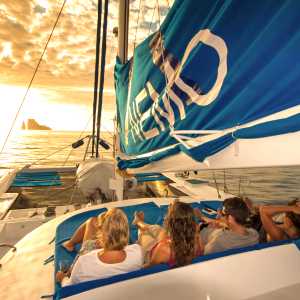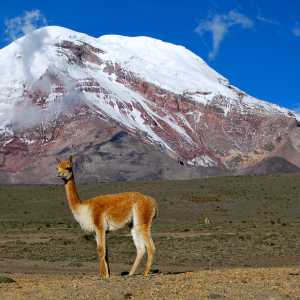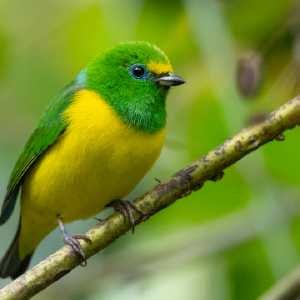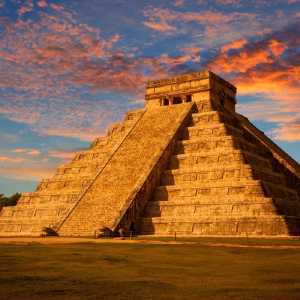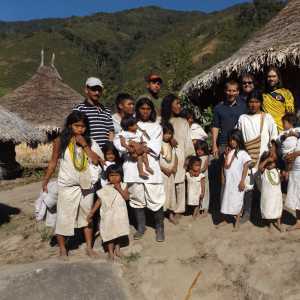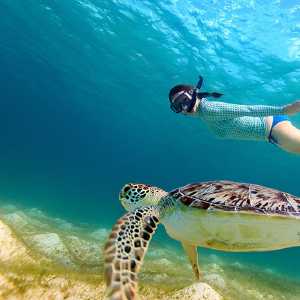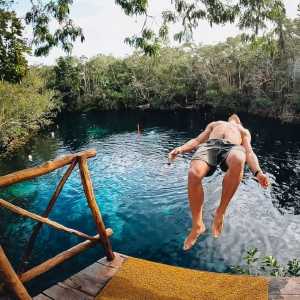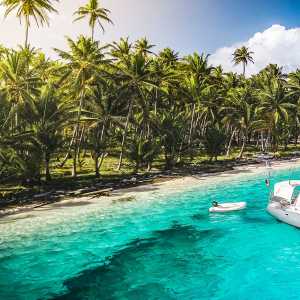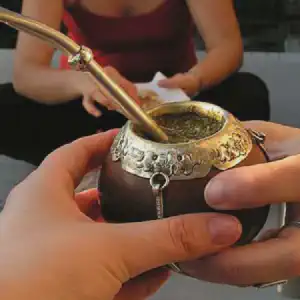Galapagos Islands
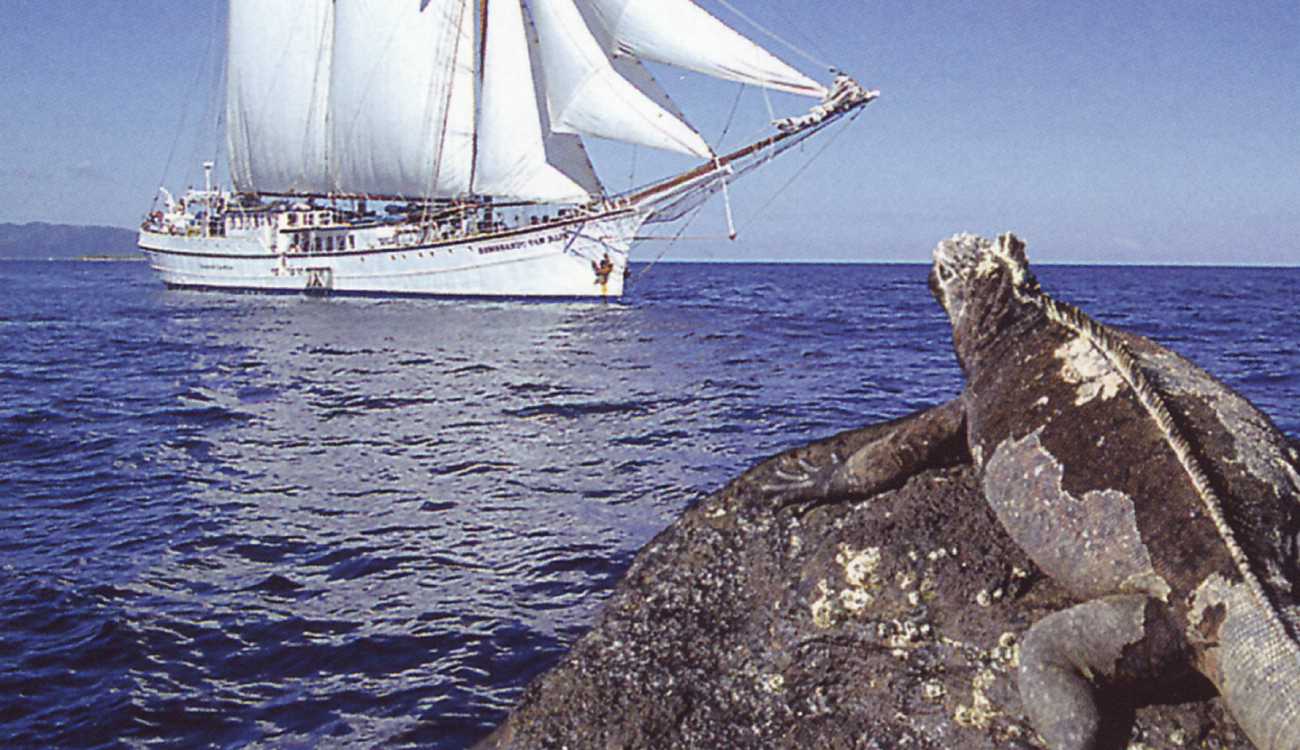
Content
Introduction
The Galapagos Archipelago is situated 1000km west of the main land of Ecuador, in the great Pacific Ocean. The islands are situated around the Equator Line. Isabela Island is by far the biggest island and there are six other islands that are over 100 km2 in size. Besides these main islands we find another twelve smaller islands and many small islets and rocks where animal and plant life is abundant. The Galapagos Islands have a very pleasant climate with a hot, wet season, which lasts from January to April, and a cool dry season that lasts from May to December. This cooler season is known for its ‘garua’ a morning mist, which could sometimes give a little drizzling rain. During a normal year, the temperature on the Islands ranges between 15 and 29 degrees Celcius. Below you will find a detailed description of all islands that have visitor sites open for tourism.
SANTA CRUZ
-
General Information
Only five islands are inhabited and Santa Cruz has the largest population of them all. It has a central location and the largest town Puerto Ayora has been the place that tourists visit the most. All sorts of vegetation can be found on this island, although much of the native flora has disappeared, due to the introduction of new plant species on the island. A great variety of bird species can be found here, probably the highest in entire Galapagos. The southeast part of the island faces the trade winds and therefore this part is much wetter. -
Puerto Ayora
Almost every visitor that comes to the Galapagos Islands will include a visit to Puerto Ayora. Not only because of the Charles Darwin Research Station, but also because it is the main center of the Galapagos. Besides that this may be your only opportunity to buy souvenirs. The bay is full of boats and you can observe many bird species and land iguanas. Puerto Ayora offers a variety of hotels and restaurants for the people that want to stay a little bit longer. -
Charles Darwin Research Station
This research laboratory is located near to the town of Puerto Ayora and is directed by scientists from several countries, who are involved in the study and protection of fauna and flora of the islands. The evolution that the islands have undergone since the formation can be seen here too. It also shows the animals that have been introduced to the different areas and possible solutions to protect them against extinction. Raising the Galapagos Giant Tortoises in captivity is the most important project the Galapagos National Park is involved with. The Charles Darwin Station carries this out. This program has enabled the return of many tortoises into their natural habitat. The Charles Darwin Station is also home of several adult giant tortoises, which have been found in other parts of the world and are later brought back to their habitats of origin. If you arrive by sea you will notice that there are huge marine iguanas on the dock.
While exploring this area you will have the chance to see a lot of varieties of Darwin finches and mocking birds. The visiting time for this place is about 2 hours.
-
Twin Craters (Los Gemelos)
You can visit the Twin Craters from Puerto Ayora by bus. Here you will descend into one of the miracles of Mother Nature. These craters collapsed because of the weight of the overlying rocks. Right now, this area is overgrown with vegetation and you can observe flycatchers and the amazing ‘woodpecker’ finch. -
Lava Tunnels (Bellavista)
The tunnels are located about 3km away from Puerto Ayora and these tunnels were born after a number of volcanic eruptions. The walk through the tunnels can be quite difficult because of the darkness. It is better if you use a flashlight, which will be provided by your guide. There are more lava tubes to find if you follow the signs ’los tuneles’. However you have to be careful when entering the tunnels, because the roof seems to be very unstable. -
Bachas Beach
The charming Bachas beach is located on the north shore of Santa Cruz Island. This is the part where the pacific green sea turtles nest and lay eggs, especially from November to February, so be careful to follow your guide, as you don’t want to step on one of the nests. Near the beach is a salt lagoon where you can see a flamingo population. Bachas beach is also perfect for swimming and here you can find marine iguanas resting on the rocks and hermit crabs in the sand. Visiting this island takes about 2 hours. -
The Tortoise Reserve
This tortoise reserve is a great opportunity to see giant tortoises in the wild. On the way to the reserve you can also see turtles grazing next to cows! Also several bird-species can be observed here like the flycatchers and the dark-billed cuckoo. Be sure to take waterproof boots and the most important thing is to bring a lot of water. It can be very hot, especially when we get back, because we’ll have to walk uphill. In the forest, it can be a little bit difficult to spot wildlife, because the forest is very dense. -
Tortuga (Turtle) bay
This bay has a beautiful white-sand beach, approximately 1 hour away from Puerto Ayora by foot. This beach is quiet because of its location. The sunsets are spectacular here, but be careful in the water as the undertow is very strong. For surfers, the cove a little bit further west is safer and calmer. On the side of the beach, there’s a big lagoon where brown pelicans and flamingos live protected by mangroves. Sharks are commonly seen here at this spot in the sea. On the other side, the coast is exposed to wind and rolling waves, so be careful when you have to swim to the shore. (Notice: there are no shops to buy food or drinks, so be sure to bring you own). -
Santa Rosa
You can take a bus to the little town Santa Rosa and take a nice walk. You may see the barn owl and the Galapagos hawk, but also look for the pair of sink holes on the road to Baltra. -
Caleta Tortuga Negra (Black Turtle Cove)
This island is perfect to see Pacific green turtles, although it is not allowed to land here. We can only enter a sheltered area with a dinghy and admire a turtle’s head coming up once in a while. From December to March, these beautiful animals breed here in peace and quiet. Also white-tipped reef sharks are often seen here. These are not the only animals we can observe, because if we are lucky, we can see the amazing eagle ray and golden rays sliding under the dinghy! This place is special and is very different from other places in the Galapagos. -
Las Grietas
Las Grietas gorge is a small pool suitable for bathers. From Punta Estrada it’s a 5-minute walk to a public path, where you’ll have to follow a clear path on the left side of the lagoon. Approximately 15 minutes later you’ll arrive at Las Grietas and it is definitely worth the trip! -
The highlands
If you want to explore the highlands it is advisable to take a guide with you. Take a rain jacket as it can get muddy and misty. On your way you can observe giant bamboo trees and dense miconia vegetation. Two highlights of the highlands are Media Luna, which is an eroded volcano cone and Cerro Crocker. This is the highest point of the islands and with clear weather; you’ll have a magnificent view on the entire archipelago!
If you want a professional guided tour on the island to the higher grounds, you can always contact ATC. These tours will include highland ranches such as Rancho Mariposa and Rancho Altair. There is also a possibility to book aquatic tours in glass-bottom boats to view marine life in Punta Estrada, Las Grietas, Isla Caamaño, Playa de los Perros and Franklin Bay. Be prepared to see birds, sea lions, marine iguanas and various marine life.
SANTIAGO (JAMES ISLAND)
-
General Information
Santiago is an island that is visited by almost any boat, because its central location in the archipelago. On the east and on the west side there are small islands. Human’s impact has been heavy, because a variety of animals, like goats and donkeys have been introduced, but still all sites are definitely worth a visit. There are plenty of flowers, insects and land birds, especially in the wet season. You can even visit an archaeological site, because there was human activity in the past. The lava flow, the seal caves and the tide pools are a few examples of sites that you can visit on the island. -
Sullivan Bay
This part of the island is mainly covered with lava. The black lava is about 100 years and full of gas bubbles. If you look very good, you can see parts of trees that were vaporized by the lava. The only plants that grow on this part of the island are a tiny carpetweed herbs and the rare lava cactus. You will be able to walk by an extensive lava field formed by twentieth century volcanic eruptions. If you look closely you will be able to see lava lizards. The landscape is impressive and a little bit difficult; don’t be afraid of asking for help if you think you need it. It can be very hot on Sullivan Bay, so bring enough water with you. The walk takes about 1 hour. -
Puerto Egas (South James Bay)
Located on the west side of James Island, this beach is composed of volcanic ashes. During the walk you will come across finches, doves and hawks, as well as a big variety of marine life during the coastal walk. At the end of the trail there are some natural pools which are formed in the lava field and where you can observe fur seals, another endemic species that live on the islands. There is a chance to go swimming and snorkeling in these pools. You can also find Darwin’s Toilet, which is almost every guide’s favorite lava tube. This is a cave that is formed by the action of the sea. There is also an industrial archaeological site on the bay. In the 1920s and 1960s two salt-mining enterprises were digging salt out of a crater to the east. You can spot flamingos near this site. On the trail between the old road and the sea you can see marine iguanas, crabs, sea snails, oystercatchers and urchins. At the end of the trail the sea lions are resting and playing in the sun. The visit to this site will take about 3 hours. -
Bucaneer Cove (Caleta Bucanero)
This was always an important place for sailors where they used to clean their ships. These days you can visit the cove and enjoy the high cliffs, which are an impressive site. On the beach you will find many sea lions and on the north there is a contorted cinder that has been eroded into many shapes. It is also famous for its spotted reefs and black beach, a considerable population of goats can be found, grazing the hillsides. For this visit the vessel will sail slowly close by these formations. -
Espumilla Beach
This is a beautiful golden sandy beach with ghost crabs, wading birds and marine turtles. Due to floods in 1983 all the flamingos went elsewhere. It has a mangrove backdrop and the wet landing can sometimes be difficult because of the breakers. There is a short trail on the beach where you can spot ten species of finch and two species of flycatchers.
ISABELA ISLAND
-
General Information
Isabela Island is about 130 kilometers long from the north to the south. With this size, the island is the biggest of all islands in the Galapagos. This island also holds the highest volcano on the Galapagos, ‘Volcán Wolf’ with a height of 1646 meters. There are several more volcanoes, of which ‘Volcan Sierra Negra’ can be climbed. At ‘Volcán Alcedo’ the largest population of tortoises can be found. -
Tagus Cove
This is a hidden site where the old ships used to go safe anchoring for over three centuries. Here you will find a lot of markings with names and dates left by every ship that used the site. This site was also used for provisioning of fresh water. The landscape is covered with dense vegetation that is typical for the area. Some of the (native) plants that you can find here are ´Muyuyo´, ´Galapagos cotton´ and ´velvet shrub´. In the area you have the opportunity to see some finches, mockingbirds, the Galapagos Owl, as well as a spectacular view of the bay and Darwin Lake. Right at the end of the trail you will find lava slopes of Darwin and Wolf volcanoes. Also there is a chance to make a panga ride along the cliff side nearby so you can observe the marine wildlife. The cliffs are colonized by marine iguanas, crabs, sea-lions and penguins. -
Volcan Alcedo
There is a wet landing on a beach with black lava sand. If you visit this island, make sure to wear comfortable walking shoes, because the trip around the island is approximately 20km and there is an extension of 12km. At these places you can find the best spots to see giant tortoises. This trip is not without effort and not the easiest one and therefore it is wise to bring band-aids. Also bring enough water and sunscreen, because there are not much places where you can find shadow. Please make sure that you have to watch your guide on our way up, because here you can get lost easily. Besides turtles you can spot other animals like hawks and flycatchers. -
Elizabeth Bay
Elizabeth Bay is the narrowest part on Isabela Island. Landing is possible here, but it takes the boat a long time to get to the coast. Once in the lagoon, there are many beautiful things to see. You can see golden rays, turtles, baby sharks and amazingly young sea lions that climb the trees! Besides that, other animals are frequently seen, including penguins, tropicbirds, herons and flightless cormorants. -
Punta Moreno
This part of the biggest island is the least visited. Not because there aren’t many things to see here, but because landing here is quite difficult. One of the most beautiful things here are the lagoons that you can find in the black lava. Surprisingly enough, these lagoons are full of life. Dragonflies, moorhens and flamingos can be found here. A quick dive in the coastal pools is very welcome although the visibility is poor under water. Other animals that can be seen are wild dogs in packs, white-cheeked pintail ducks, herons, martins, sandpipers, plovers and pelicans! -
Urvina Bay
The landing here is far from dry and you can get wet until your waist, so make sure that you put all your personal things in plastic bags and make sure they make it to the shore without getting wet. You can walk the whole circuit in two hours, but is it recommended that you choose between two different walks, mainly because of the heat and the dense vegetation. You can choose to go inland to look for giant tortoises and the other possibility is to walk along the coast to look for other animals like cormorants. In the rainy season, turtles can be found right behind the beach. That’s why it is smart to go ashore as early as possible to see them. Other animals that can be seen here are cormorants, land iguanas and hermit crabs. In this part of the island you can find the ´manzanillo´ or poison apple trees. Beware of them as their sap can cause a nasty rash. -
Puerto Villamil
Near this little town with 1400 inhabitants, you can find beautiful beaches. It’s lovely out here, although you have to watch out for the strong undertow in the water. A 30-minute hike takes you to ´Centro de Crianza´. This is a breeding centre for giant tortoises. ´Muro de las Lágrimas´ is a historical place that can be visited and it is about 2 hours from Centro de Crianza. On the other side of the town, also a 30-minute walk, you’ll find ´Concha Perla Lagoon´. Here you have the possibility to go swimming with sea lions and other creatures. Santo Tomás is a small village located some 20km from Puerto Villamil, where you can rent horses for around US$ 10 per day (always depending on the destination). Snorkelling can be practiced east of the port and there are wonderful beaches to practice surfing west of Puerto Villamil.
FERNANDINA ISLAND
-
General Information
Fernandina lies most west in the archipelago. It is the youngest island and has the most active volcano. This volcano almost reaches 1500m and it is not possible for visitors to climb Fernandina, because of the volcano’s activity. All the plants and creatures arrived naturally. This is the only site where you can admire the flightless Cormorants. -
Punta Espinosa
This point of Fernandina exists of lava and sand and is really beautiful, because the six volcanoes on Isabela Island surround you. Between Fernandina and Isabela lies the Bolivar Channel and here you can observe dolphins, boobies and even whales. You can enjoy the unique Mars landscapes, turtles in a tide pool, penguins and many more. There is a huge colony of many marine iguanas on the island. These black reptiles breed between January and June and lay their eggs in the sand. More to the west you will find different kind of mangroves, a favourite place for crabs, great blue herons, oystercatchers and marine turtles. On the beaches you can see the sea lions resting. You have also a possibility to see the Galapagos hawk, yellow warblers, mangrove finches, lava lizards and cormorants. The cormorants are the most peculiar birds of this island, as they are flightless. The landing is dry, but when the tide is low, most of the time you’ll wade to another point on the island. The visit of this spot is about 2 hours.
DAPHNE MAYOR
This island is the most restricted area of the Galapagos, only a few yachts are allowed to sail here, the people who go ashore have a wonderful experience of an island full of blue-footed boobies and more Galapagos species. Take your camera and shoot the pictures of your life! At the summit of the trail there’s a nice view on two craters. Visitors are not allowed to go down into the crater because of the heat and other volcanic dangers. This island has a very rich bird life, so be careful that you don’t step on one of the many nests!
ISLA MOSQUERA
This little, with coral sand covered, Lava Island gives you the idea of a exploration tour. The only things you’ll find on this spot are many sea lions and plants like ‘seaside heliotrope’ and ‘sea purslane’. Only a few boats will visit this island because it’s not an easy landing at low tide. Once if you have climbed over boulders, which are the homes of many sea lions, you can enjoy the beauty of the island.
NORTH SEYMOUR
North Seymour is the most visited island of them all. This island has a big sea lion and iguana population. The blue-footed boobies nest all over the island, courting and mating in front of the visitors. You can see the frigate birds right by the trail. Disembarking on this island can be a little difficult and it will require the help and assistance of your guide and crew. Other animals that can be seen here are brown node terns, pelicans, frigates, lava-gulls and tropicbirds. The walk along the Palo Santo trees and low shrubby type opuntia takes about 2 hours.
SANTE FE (BARRINGTON ISLAND)
Only small boats can enter the island, because of the shallow waters. The arrival here is truly impressive; a great white beach and the water that is turquoise colored. A forest of Opuntia cactus covers the Island. The walk is easy and short and on the trails you can find land-iguanas chewing on the fallen cactus pads. These iguanas are different from the ones you find on the South Plaza Islands. This iguana is a lot bigger! Other animals that can be found here are sea lions, yellow-tailed surgeonfish, sergeant majors, damsel- and parrotfish, stingrays, white-tipped reef sharks, rodents, Galapagos doves and snakes. The beach side is perfect for swimming and snorkeling. The excursion time will be approximately 2 hours.
SOUTH PLAZA
The Plaza Islands, North Plaza and South Plaza, are small but have a great variety of flora and fauna. Only South Plaza is open for visitors. On this southern island you will find the smallest species of land iguanas, but also nests of gulls, boobies, frigate birds, tropicbirds, marine iguanas, lava lizards and on the dock are often large male sea lions and their young resting. It can be difficult to get on land because of the sea lions there are on the dock. Often the guides have to shoo them away by clapping. Snorkeling off South Plaza is not allowed because there are too many sea lions. Offshore you can spot shearwaters, terns, mullet and surgeonfish. Farther out dolphins, mantas and killer whales have been seen. The island itself is an uplifted piece of sea floor. The island is only a kilometer long and a little wider than 100 meters. A big part of the island is dry with platforms of polished lava, parts without any trees, but many yellow flowers. The cliff is very steep and windy. From here you can observe the birds we described above perfectly.
SAN CRISTOBAL
-
General Information
The airport of San Cristóbal is one of the two airports in Galapagos. The Visitor Interpretation Center that has been build attracts more tourists and also the town of Puerto Baquerizo Moreno is gaining some popularity. -
Puerto Baquerizo Moreno
This city, the official capital of the whole archipelago, is home to one of the two main airports in the Galapagos region. It is known as a sleepy town overlooking the harbour with a truly relaxed attitude. This was once a little village, but now it has grown a lot in a few years. You can also find the Visitor Interpretation Centre close to this town. Bring your own refreshments because this cannot be bought at the centre. It is a good idea to visit the frigate bird hill close to the centre. The views and the birds are amazing! On the beaches around the town you can set up a campsite, although it is one of the few places where it is allowed to do such thing. For the people who are interested in staying a longer time, there are a number of hotels and restaurants where you can stay comfortably for a few days or even longer. -
Figatebird Hill (Cerro de las Tijeretas)
Here you can make a roundtrip of 2km to see the beautiful views and birds of this location. You’ll have a view on the white sandy beaches and on the other side Puerto Baquerizo Moreno. Both species of frigate birds can be observed here. Nearby is a beach where you can rest a little and take a swim. -
El Junco Lagoon
This lagoon is a beautiful sighting because of its great diversity of endemic life. If you want to do a round trip, you need a vehicle. This is the only freshwater lake of entire Galapagos and here you can find gallinules, seven species of Darwin’s finches, White-cheeked pintail ducks, semi-palmate plovers and many more. It is a little bit difficult to spot the Darwin finches, but if you try hard enough, you will find them. The environment is very pleasant and beautiful here, because many of the aquatic plants are rare. Galapagos Miconia, also known locally as cacaotillo is one of the endemics of San Cristobal and Santa Cruz and once covered the entire vegetation zone at around 500m altitude. Presently however grazing endangers this plant zone, burning and competion by introduced plants. The Bracken Fern is common on the higher altitudes and found in the Miconia and Fern-Sedge or Pampa zone. The Pampa zone is continuously wet in the cool season and formerly only ferns, club mosses and tree ferns grew there. Introduced trees like the quinine tree and the cattle grazing now threaten the native plants of this vegetation zone. Flowering plants growing in those higher parts around the lake. The round trip takes approximately 3 hours. -
Punta Pitt
All three species of boobies can be seen here, the red-footed, blue-footed and the masked boobies. If you enter this part of the island, you have to make a wet landing and sea lions will welcome you to the shore. The views are astonishing and that’s why it makes the climb worthwhile. -
La Galapaguera
This is a new visitor site in the northeast part of San Cristobal Island and can now be reached in roughly one hour by road from Puerto Baquerizo. This passionflower, also known as Running Pop, is native to the isles and very common growing as a vine. In the trees and shrubs surrounding the site, land birds like warbler, finches and mockingbirds can be observed. Darwin’s Cotton is endemic and found on many islands. The white lint it produces is however not used for any commercial purposes. Another common plant with beautiful yellow flowers is the Yellow Cordia, native to the Galapagos but also to mainland Ecuador and Peru. This shrub or tree can grow up to 8m in height and its valuable wood is used in carving. The fruits are a food source for birds and rats and its pulp can be used for sealing, as it is very sticky. The sweet aroma of the flowers attracts carpenter bees and sulfur butterflies. Bees however steal the nectar by making a small slit at the base and thus not pollinating it. On the trails Giant Tortoises can be encountered. They live there in the wild but in a protected area so they can assure their survival by sealing them off from introduced predators, like pigs and goats. Once the tortoise perceives danger, it goes into its defensive stance, retreating into its hard shell. Manzanillo or poison apple tree belongs to the Spure family and as its name suggest is poisonous. Do not eat the fruits and avoid getting into contact with its sap. View over the vegetation to the Pacific Ocean below. On the trails you get to know many plants common to the dry lowland and moist upland regions. -
La Lobería
It’s important that you do not deviate from this trail, but if you get there you’ll be amazed by several sea lions, marine iguanas and bird life and further along the cliff are rays and tortoises. -
The highlands
It is possible to explore the highlands on your own. Though local guides are available, it is not obligatorily to hire a guide. You can explore the island by foot or you can hire a truck. You can bring a visit to the top of a volcano. Here you’ll be treated to a magnificent view on the ´El Junco lagoon´, which is a haven for frigate birds. If you hike around this lake, you’ll get to see almost the entire island from up here. The island’s highest point is San Joaquin Hill, which is best reached by truck. -
Playa Punta Carola
Playa Punta Carola is a perfect place for surfers, but swimmers have to go a little further north to Playa Mann through Avenida Northia. Playa de Oro is located here too, where you can find several hotels.
A few tall rocks in the sea are called León Dormido (sleeping Lion), because the Spanish thought it had the shape of a sleeping lion. The cliffs are cut through the middle, there are boats that can pass through this narrow sea channel, but most of the boats pass close to the rocks to watch the masked boobies and red-billed tropicbirds. This beautiful place is a one-hour sail away from Bacquerizo Moreno Port. Make sure your binoculars and cameras are within your reach while we navigate around the rock, because there are many chances to observe hundreds of blue-footed boobies standing in their little caves. Further away, observe the frigate birds in the bushes of the coast side, when it is courting season you will be able to see a wonderful show of their brilliant red pouches.
ISLA LOBOS
This is a small rocky islet, but very peaceful. The only way to arrive on the islet is by making a wet landing. On the short trail (300m) you can see the candelabra cactus and many blue-footed boobies. Also there are a lot of sea lions (lobo means sea wolf in Spanish, although it is a short name).
ESPANOLA (HOOD ISLAND)
-
General Information
This is one of the most unique and isolated islands of the whole archipelago, because of its enormous diversity of animals and landscapes with for example its famous blowhole. There are two visitor sites on the island and they are totally different from each other. One of them is a beautiful white sandy beach and the other one is a rocky trail. -
Punta Suárez
This is certainly one of the highlights of every cruise. A group of young sea lions is your welcoming committee, they just love to swim and jump around the boat, while you approach the island. When disembarking, the Hood mockingbirds will come very close to you, as they are not shy at all! Just remember that touching the animals is forbidden, however there are no rules prohibiting the mockingbirds from landing on your head. After this warm reception you will have a chance to observe colorful marine iguanas and beyond this point the path becomes rockier. If you have trouble with this rather difficult path, you can always ask a friend to help you. Lava lizards and large billed finches are seen very often. The blue-footed colony is so populous that you have to watch your step not to stand on one of their nests. Enjoy the moment when you see the brilliant red-billed tropicbird flying around. Furthermore you will have a chance to have rest just sitting by the cliff side where you can have a beautiful view of the island and its wildlife. Furthermore you will discover a natural geyser called the blowhole. From March to December it is possible to see the Waved albatross. These birds have a very special manner of courting. Hood Island is considered a special breeding site for this bird. Visiting this island will take about 3 hours and we recommend you to wear comfortable walking shoes, a high protection of sun block, and take an extra film for your camera! -
Gardner Bay
Located at approximately 45 minutes from Punta Suarez, Gardner Bay has a brilliant white sandy beach with hundreds of barking sea lions. This place is perfect for relaxing and snorkeling. There are 3 species of finches on this part of the island and other animals that you can find here are turtles, martins, small wading birds, surgeonfish and white-tipped reef sharks!
FLOREANA ISLAND
-
General Information
Many animals are disappeared here because this is the first island that was inhabited by human. This is also the reason why many species have been introduced here and the giant tortoises can also no longer be found on the island. This island was an active volcanic island, but now it’s covered with forests. This islands offers one of the few sites in Galapagos where flamingoes can be observed. -
Devil’s Crown
This is a submerged volcanic crater beside Punta Cormorant, the cold waters of this place permit an abundant marine life. The boat will anchor inside the crater allowing you to swim and snorkel, but always be careful of the strong current around the crown. You will have the opportunity to see hammerhead sharks, king angelfish, starfish, stingrays, parrotfish, they all are found frequently in the area. You will spend here approximately 1 hour. -
Punta Cormorant
This beach has an emerald green color due to its high content of olivine crystals. While disembarking (wet landing) there will be a small colony of sea lions and beyond ahead is a salt lagoon where you will see some flamingos, as well as pintail ducks. Continuing the walk you will see some different plants and Darwin finch species, yellow warblers, vermilion flycatchers, short-eared screech, owls, and common abundant gallinules. Right at the other side there is a white-sanded beach where you can see some manta rays, ghost crabs, black tailed sharks and marine turtle nests. The excursion takes about 3 hours. -
Post Office Bay
A long time ago, a British ship placed a barrel on the island to leave messages for travelers. This barrel is now used to send postcards come. This island has a wet landing and nearby the barrel there is a trail, which leads to a lava tube. The skeletons of turtles can be found here.
BARTOLOME ISLAND
Climb up to a peak of a carbonous cone 359 feet high (109m) and experience one of the most beautiful views of all the surrounding islands. The ascension takes about half an hour. The trail is not difficult as there are steps that will help make your climb easy. Take a walk through moonscape-like landscapes overgrown with Tiquilia, the island’s vegetation. After this walk disembark onto a beautiful brown-sanded beach with its Pinnacle Rock. It’s perfect for snorkeling and swimming, you can even swim together with Galapagos penguins! Simply enjoy the big variety of marine life. The beauty of this island will amaze you!
GENOVESA (TOWER ISLAND)
-
General Information
This island is far away from the other islands, as it lies in the north east of the archipelago. It is worth sailing to, because there is a huge sunken crater, where the views are magnificent. You can also sail into this crater. This island offers the biggest colony of red-footed boobies in the entire Galapagos! -
Darwin Bay
Darwin Bay is an exotic, partially eroded volcano, famous for its crater walls, hundreds of magnificent frigate birds, red-footed boobies, swallow tailed gulls and brilliant storm petrels, which all mate here. Darwin beach exists of white coral remains and during high tide a great part of the beach is underwater. The coral is quite sharp, so be sure to ware sneakers or sandals. Here the marine iguanas are the smallest of all in the Galapagos. Snorkeling can be amazing here, although visibility is poor and sharks are common here. -
Prince Philip’s Steps (El Barranco)
Prince Philip’s step is a rocky climb, a 25m ascent to the open ground above. Here is where you find boobies, just having a great time on this beautiful part of the island. At this island there is an almost flat trail of 2km and here you can walk across fields of lava. This is a full day visit as the vessel stays in the bay.
RABIDA (JERVIS ISLAND)
The red color of the sand, its surroundings and the mixture of orange and gold hues shining in the sunlight make this a very mysterious island. The landing is wet and you can spot brown pelicans nesting here among the mangrove vegetation, flamingos and long-tailed, white checked pintail ducks play around in the lagoon. Other animals that can be seen are Galapagos hawks, Galapagos doves and mockingbirds. Swimming and snorkeling is recommendable near the beach. Under water you there is a chance to spot the pelican fish. Approximate 1-hour visit.
SOMBRERO CHINO
This is one of the most beautiful isles in the whole archipelago. It has a turquoise-colored channel, spatter cones, lava tubes and pahoehoe lava. There is only a short trail along the coast because of the fragile formations that are situated over here. On this island you will find marine iguanas, sea-lion cubs and orange crabs. You can snorkel in the channel and find some penguins here. In the deeper parts of the channel are manta rays and sharks. Near the beach are a lot of plants including the lava cactus.




